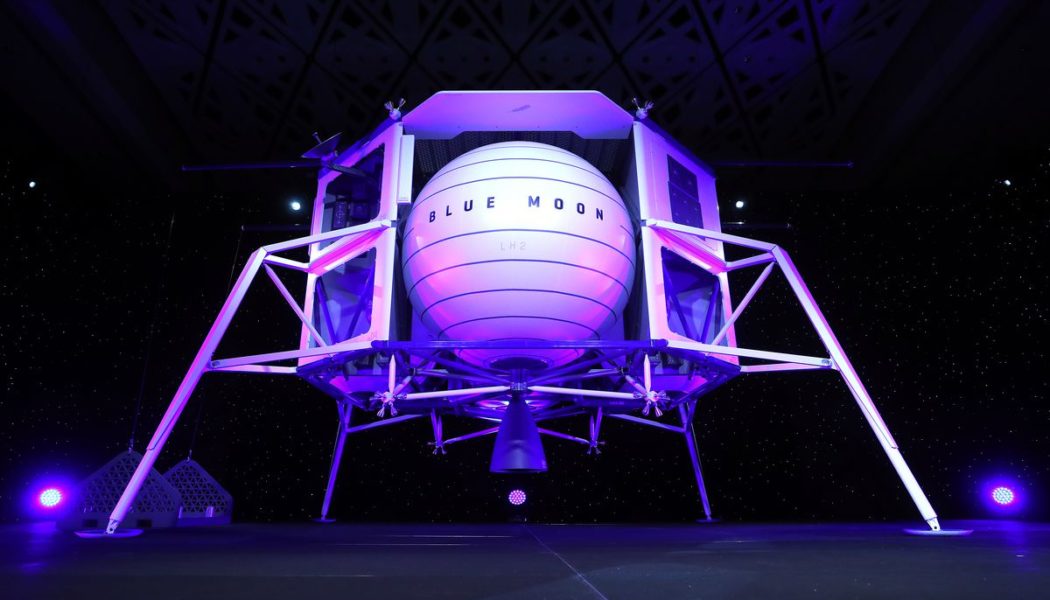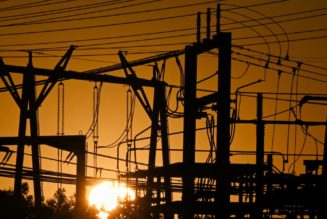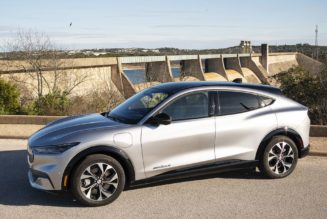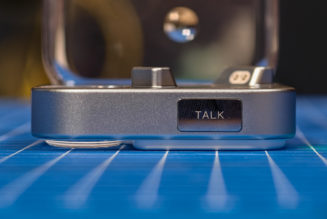Jeff Bezos’ Blue Origin “gambled” with its Moon lander proposal last year by hoping NASA would be willing to negotiate its $5.9 billion price tag, agency attorneys argued in blunt legal filings obtained by The Verge. NASA, cash-strapped with a tight budget from Congress, declined to negotiate and turned down Blue Origin’s lunar lander in April and picked SpaceX’s instead, sparking ongoing protests from Bezos’ space company.
NASA officials haven’t talked much about Blue Origin’s legal quarrels beyond occasional acknowledgements that the company’s protesting — first at a watchdog agency and now in federal court — is holding up the agency’s effort to land humans on the Moon by 2024. But in hundreds of pages of legal filings The Verge obtained in a Freedom of Information Act request, agency attorneys exhaustively laid out NASA’s defense of its Artemis Moon program and doubled down on its decision to pick one company, SpaceX, for the first crewed mission to the lunar surface since 1972.
Round 1: A Costly Bid
In NASA’s main response to Blue Origin’s protest, filed in late May, senior agency attorneys accused the company of employing a sort of door-in-the-face bidding tactic with its $5.9 billion proposal for Blue Moon, the lunar lander Blue Origin is building with a “National Team” that includes Lockheed Martin and Northrop Grumman. Blue Origin was “able and willing” to offer NASA a lower price for its lunar lander but chose not to because it expected NASA to ask and negotiate for a lower price first, the attorneys allege, citing a six-page declaration written by the company’s senior vice president Brent Sherwood in April.
In the declaration, Sherwood complains that NASA “did not afford Blue Origin, a well-funded private space company backed by Jeff Bezos, any opportunity to submit a revised business position” when NASA found out it wouldn’t have enough money from Congress to fund two lander proposals. He said Blue Origin had already committed “almost one billion dollars” of corporate contributions and private investments to the Moon lander bid, and “had the financial potential to increase” that.
Backed by the world’s richest man, Blue Origin indicated in its protest that the $5.9 billion price — nearly double SpaceX’s proposal — was partially based on an assumption that NASA would have more than enough money from Congress to pay for the proposal, even as Congress had been indicating a month before Blue Origin submitted its proposal last December that it wouldn’t give NASA all the funding it said it needed. In NASA’s response, the attorneys said companies were instructed to submit their best proposal first. They pointed to seven instances where NASA told bidders its award decision, and whether to pick one or two companies was based on how much funding it’d end up getting from Congress.
But Blue Origin argued that NASA should’ve canceled or changed the terms of the program when Congress voted to give the agency only a quarter of what it requested. Blue Origin has also argued that it was unfair of NASA to only invite SpaceX to tweak parts of its proposal after selecting it for a potential award, one of many claims that NASA attacked over hundreds of pages of legal rebuttals.
Overall, NASA effectively called BS on that argument, saying “Blue Origin made a bet and it lost.”
Blue Origin “made an assumption about the Agency’s HLS budget, built its proposal with this figure in mind, and also separately made a calculated bet that if NASA could not afford Blue Origin’s initially-proposed price, the Agency would select Blue Origin for award and engage in post-selection negotiations to allow Blue Origin to lower its price. All of these assumptions were incorrect,” the four NASA attorneys wrote in the so-called Agency Report, dated May 26th. “Realizing now that it gambled and lost, Blue Origin seeks to use GAO’s procurement oversight function to improperly compel NASA to suffer the consequences of Blue Origin’s ill-conceived choices.”
:no_upscale()/cdn.vox-cdn.com/uploads/chorus_asset/file/22887120/1148070217.jpg)
The company disagrees with NASA’s assessment. “I wouldn’t say that we didn’t offer our best offer when we put in our proposal … I think we did give a great offer,” Megan Mitchell, Blue Origin’s vice president of government relations, told The Verge in an interview. “I’m not going to comment on NASA characterizing it as gambling — we disagree with that.”
The lunar lander program is the centerpiece of NASA’s efforts to get humans on the Moon under a speedy 2024 timeline, set two years ago by the Trump administration. SpaceX, the sole awardee of the Moonshot phase of the program, will carry out two core missions: a demonstration mission to the Moon’s surface without any astronauts and a subsequent mission with astronauts. Blue Origin’s National Team and defense contractor Dynetics were the two bidders with lunar lander proposals that lost to SpaceX.
Blue Origin executives may have thought that the negotiation tactic would work because it had in the past. In April 2020, a year before SpaceX’s $2.9 billion award was made, all three bidders were awarded some NASA development funding in an initial phase of the program intended to help the companies build up their respective lunar landers. SpaceX got $135 million, Dynetics got $253 million, and Blue Origin’s National Team got $579 million.
Blue Origin had initially proposed roughly $879 million for those development contracts when proposals for the award were due in November 2019, NASA filings indicate. Blue Origin offered a roughly $300 million discount and dropped the price by about 35 percent, to $579 million, after NASA requested meetings to negotiate. The agency attorneys said the outcome of these discussions, where Blue Origin ended up winning the biggest chunk of funding, inspired Blue Origin’s “gamble” with the subsequent competition, where it pitched its Blue Moon lander for $5.9 billion. “But NASA had no obligation to make this request” for a negotiation that time around, they wrote.
“This time, the bet simply did not work out in Blue Origin’s favor.”
Sherwood’s declaration from April was one of several attempts to show that NASA was prejudiced in favor of SpaceX and acted unfairly against Blue Origin. But NASA said “a vague commitment to a sizeable, non-specific discount is not enough to demonstrate prejudice.” Months later, and just four days before the Government Accountability Office (GAO) ruled on Blue Origin’s protest, Bezos himself stepped in and got specific in an unusual open letter to NASA administrator Bill Nelson. Bezos said he would give the agency a $2 billion discount on Blue Origin’s proposal.
But it wasn’t enough to change minds at NASA. The GAO ultimately sided with the agency, saying that showing examples of prejudice “is an essential element of any viable protest,” and that Blue Origin failed to do so. As for Blue Origin’s argument that NASA’s discussions with SpaceX were unfair, since Blue Origin didn’t get the same chance to talk, the GAO brushed it off, saying agency officials have “broad discretion” to meet when and with whom they please under the type of contracting rules involved. “An agency’s decision not to initiate discussions is a matter we generally will not review,” GAO attorney Thomas Armstrong said in a ruling.
Blue Origin’s protest, though, wasn’t a complete failure. It alleged that one of the ways NASA gave SpaceX an unfair advantage was when the agency, for SpaceX only, “waived” its requirement to schedule government safety reviews before each launch of its Starship vehicle in its proposal. These safety reviews, called Flight Readiness Reviews, should come 14 days before each rocket launch within the company’s plan to get to the Moon, per the rules of the competition. Blue Origin’s proposal had indicated it could send Blue Moon to the lunar surface in as much as three commercial rocket launches with a safety review for each launch.

SpaceX’s proposal involved 16 launches, with just one official safety review. The 16 launches include one launch of an orbital fuel station, 14 launches of “fuel tankers” to fill up the fuel station in orbit, and one launch of the Moon-bound Starship that will fill up at the fuel station to travel the rest of the way to the lunar surface (launching off Earth uses up a lot of fuel, so Starship will need a top-off before it carries on to the Moon). SpaceX said each of the roughly 14 fuel tankers would launch 12 days apart, a cadence that NASA officials said was “logically inconsistent” with its requirement to have a safety review 14 days before each launch. So when NASA invited SpaceX to negotiate the terms of its proposal, they agreed to have three reviews in all, one for each type of rocket launch — one for the orbital depot, one for all the tankers, and one for the Moon-bound Starship.
But that’s where NASA messed up, Blue Origin claims. And for once, the GAO’s Armstrong partially agreed. NASA attorneys said the agency’s rules were broad enough to allow flexibility with the reviews, but Armstrong sided with Blue Origin’s interpretation that a single review had to come before each launch. Still, Armstrong denied Blue Origin’s overall argument because the company didn’t explain how NASA’s alleged screwup gave SpaceX an unfair advantage.
Round 2: Suing NASA
To Blue Origin attorneys, the GAO ruling was valuable feedback for a new legal challenge, this time in the US Court of Federal Claims — the last venue capable of hearing contract grievances.
Blue Origin sued NASA in court weeks after the GAO rejected its protest. In its complaint, which was shrouded under seal until last week, the company centers its new fight on the main area it fell short on during the GAO dispute: proving NASA was prejudiced against Blue Origin and gave SpaceX an unfair advantage. The debates over SpaceX’s Flight Readiness Reviews, where the GAO signaled its support for Blue Origin, is the basis for its unfair advantage argument.
“That is not what SpaceX proposed, it is not in the final architecture, and that’s the problem,” Blue Origin’s Mitchell said of the revised safety reviews. “For Blue Origin, and I think more broadly for our entire industry, this is a serious safety issue.”
Pushing back on Blue Origin’s arguments in a white paper sent to lawmakers earlier this month, a copy of which was obtained by The Verge, SpaceX said it plans to conduct safety reviews prior to every Starship launch, as it has in the past “for every single operational launch and test flight,” and that Blue Origin is conflating mere contract payment dates with actual safety reviews. It dismissed Blue Origin as a sore loser: “These claims from a losing bidder are patently inaccurate.” And SpaceX CEO Elon Musk tweeted last week: “We always do flight readiness reviews! This argument makes no sense.”
We always do flight readiness reviews! This argument makes no sense.
— Elon Musk (@elonmusk) September 22, 2021
Blue Origin argues in its 59-page complaint that, had the company known NASA was going to be flexible on the safety review requirements, it would’ve “engineered and proposed an entirely different architecture” for a lower price that would’ve given it a “substantial chance for award.” Specifically how NASA’s flexible safety review requirements would allow Blue Origin to change its proposal of just three review-worthy launches is unclear. The company attempted to explain how in a small paragraph in its complaint, but it was mostly redacted.
NASA made little to no mention of Blue Origin’s safety review argument in its main response to the GAO protest, and it’s unclear what the agency is saying in court, because much of it is under seal. But when it invited SpaceX to revise its proposals in April, NASA said it believed three safety reviews for each type of rocket launch “meets the intent of” the review requirements outlined in NASA’s competition rules. In other words, NASA figured its modified safety review arrangement is good enough, considering how novel and unexpected SpaceX’s approach of launching several Starships in such a rapid cadence is. And in another recently unsealed filing, SpaceX says its unconventional Starship approach is the result of NASA encouraging companies to have the “liberty to propose a different architecture.”
:no_upscale()/cdn.vox-cdn.com/uploads/chorus_asset/file/22887143/51369631902_ce4f03c26a_k.jpeg)
Now, NASA wants all the litigation to stop as soon as possible so the gears of its lunar lander program can start turning. The agency agreed last month to pause SpaceX’s contract while the lawsuit carries on only if Blue Origin agreed to a quicker litigation schedule that wraps up November 1st. Blue Origin, NASA, and SpaceX are currently duking it out before the court, most recently arguing over Blue Origin’s request to add more documents and internal NASA emails into the court’s record for review. The company also wants the judge to approve the release of a less-redacted version of its complaint, but NASA and SpaceX are pushing back.
If the court ultimately agrees with Blue Origin and finds NASA messed up, the agency would likely have to cancel SpaceX’s contract, as Blue Origin requests, and reopen the competition to allow the companies to submit new proposals — a significant setback for the agency’s Moon program. If Blue Origin loses, the monthslong hold on SpaceX’s contract would disappear, allowing work with NASA on Starship to begin, and Blue Origin would be invited to pitch its lander for a future Moon lander competition. But the delay itself already poses risks for NASA. In one of its filings to the GAO, NASA attorneys laid out their fears:
“What begins as a mere procurement delay all too easily turns into a lack of political support, a budget siphoned off for other efforts, and ultimately, a shelved mission.”
Read the lightly redacted version of NASA’s “Agency Report” to the GAO, filed in May in response to Blue Origin’s protest.









